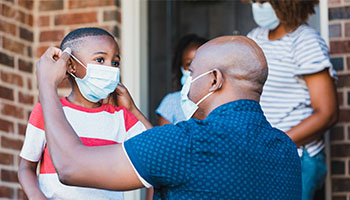HOW CAN WE HELP YOU? Call 1-800-TRY-CHOP
In This Section
A Large, Nationwide Pediatric Cohort Tested for SARS-CoV-2

Researchers evaluated SARS-CoV-2 testing data for more than 135,000 pediatric patients across the United States.
The Findings:
Researchers published findings of their assessment of 135,794 pediatric patients who were tested for SARS-CoV-2, and they found that while the risk of infection appears to be generally low (4 percent positivity rate), a disproportionate number of patients who identified as Black, Hispanic, or Asian race/ethnicity tested positive for SARS-CoV-2. Patients with some existing chronic illnesses, as well as older children and adolescents, were more likely to test positive.
A higher proportion of patients with negative test results were young children, had commercial insurance, and underwent testing as inpatients. In contrast, patients with positive results were more likely to be Black, Hispanic, or Asian (even though the rate of testing for patients from these racial/ethnic groups was below that for White patients); undergo testing in the emergency department; and be insured by a public insurance program such as Medicaid.
Having an existing chronic disease also appears to be associated with SARS-CoV-2 infection, with a strong association between positive test results and types 1 and 2 diabetes and chronic use of immunomodulators. Asthma was not associated with positive tests. Further investigation is needed to identify patients who may benefit from additional testing and risk reduction.
Of the 5,374 (4 percent) patients with positive test results, 359 (6.7 percent) met the researchers’ criteria for severe illness, being admitted with respiratory, cardiovascular, or COVID-19–specific diagnosis codes. The majority of patients tested (82 percent) were recurring patients who had a test-positivity rate of 3.6 percent, while nonrecurring patients showed 5.6 percent test-positivity rate.
Why it matters:
As part of PEDSnet, a pediatric learning health system, CHOP researchers were able to rapidly evaluate the effect of SARS-CoV-2 infection on the pediatric patient population across the United States. In addition to CHOP, participating PEDSnet institutions include Cincinnati Children’s Hospital Medical Center, Children’s Hospital of Colorado, Nationwide Children’s Hospital, Nemours Children’s Health System, Seattle Children’s Hospital, and St Louis Children’s Hospital. Annually, PEDSnet institutions provide services to about 3 percent of U.S. children, approximately 7 million patients. This volume of data enables researchers to rapidly establish learning on a large scale, test hypotheses developed in smaller case series, and detect emerging patterns of disease biology and therapeutic effects across large populations of children, including acute and late effects of the coronavirus.
Who conducted the study:

L. Charles Bailey, MD, PhD, one of the lead authors of the study.
Joint first authors L. Charles Bailey, MD, PhD, attending physician and director of the PEDSnet data coordinating center, and Hanieh Razzaghi, MPH, assistant director of the PEDSnet data coordinating center, in the Department of Pediatrics, Department of Biomedical and Health Informatics, and Center for Applied Clinical Research at Children’s Hospital of Philadelphia, were joined by co-authors Evanette Burrows, MPH, principal data integration analyst; Cortney Bruno, MSW; and Christopher Forrest, MD, PhD, director of the Center for Applied Clinical Research; as well as co-authors from other PEDSnet members. Drs. Bailey and Forrest also hold faculty appointments at the Perelman School of Medicine at the University of Pennsylvania.
How they did it:
This study captured the experience of seven large pediatric health systems using PEDSnet, a collaborative learning health network that shares inpatient and outpatient electronic health record data (EHR), conducts research and outcomes improvement, and contributes to initiatives such as OHDSI (Observational Health Data Sciences and Informatics) and PCORnet (the National Patient-10 Centered Clinical Research Network). PEDSnet institutions provide care for both healthy pediatric patients as well as those with medically complex conditions.
The researchers evaluated testing data for SARS-CoV-2 across the network from March 1, 2020, through Sept. 8, 2020, and they described patient characteristics associated with testing and infection. Included patients were less than 25 years of age prior to March 1, 2020, based on institutional policies for the transition of patients to adult care.
The study team subdivided tested patients into test-positive results without severe illness, test-positive results with severe illness, and test-negative test results. When a patient had multiple test results, the investigators classified them as test-positive if any reverse-transcriptase polymerase chain reaction test result was positive or a serologic test result was positive and no negative reverse-transcriptase polymerase chain reaction results were present. They defined severe illness as hospitalization no earlier than seven days prior to the testing date and an inpatient diagnosis of pneumonia, sepsis, respiratory failure, or COVID-19 illness. The researchers compared demographic and clinical features across the all groups.
The number of weekly tests performed increased sharply from the first week of March to the third week of July; this increase was associated with adoption of preemptive screening of inpatients and patients scheduled to undergo aerosol-generating procedures.
Some limitations to this study were inherent in the secondary use of EHR data, and some arose within the context of the rapidly changing pandemic response. Because the analyses are based on data from clinical care across a large population of patients, the conclusions may be influenced by evolving patterns in clinical decision-making and healthcare utilization. The study also used viral genome detection, given its specificity for SARS-CoV-2 infection; however, this approach excludes patients with COVID-19 illness when viral testing was not readily available or differentially available across sites, as well as those with asymptomatic or mild cases not reaching current thresholds for testing. The authors anticipate that this limitation will decrease as testing becomes more widely available.
Quick thoughts:
“We’ve seen in adults that Black patients are often more severely affected; both chronic illness and disparities in access have been concerns. Here we have a population of pediatric patients, most of whom don’t yet have chronic illnesses seen in older adults, and we’re already seeing that kind of differential positivity,” Dr. Bailey said. “We also see effects of some chronic illnesses, but not all. Older children are more likely to have positive tests, too, though it’s not clear whether this happens because of different susceptibility or different social environment.”
What’s next:
Additional research is needed to evaluate to what extent the higher positivity rate reflects different testing strategies across subpopulations, different social determinants of risk — such as exposure to air pollution, housing density, and likelihood of family continuing to work at in-person essential jobs — or differences in disease biology associated with different rates of symptomatic presentation. A better understanding of viral and host biology will enable a more effective response to SARS-CoV-2 and will be critical in developing sustainable ways to minimize the disease burden caused by SARS-CoV-2.
Where the study was published:
Where to learn more:
Read the CHOP press release about the current study.


